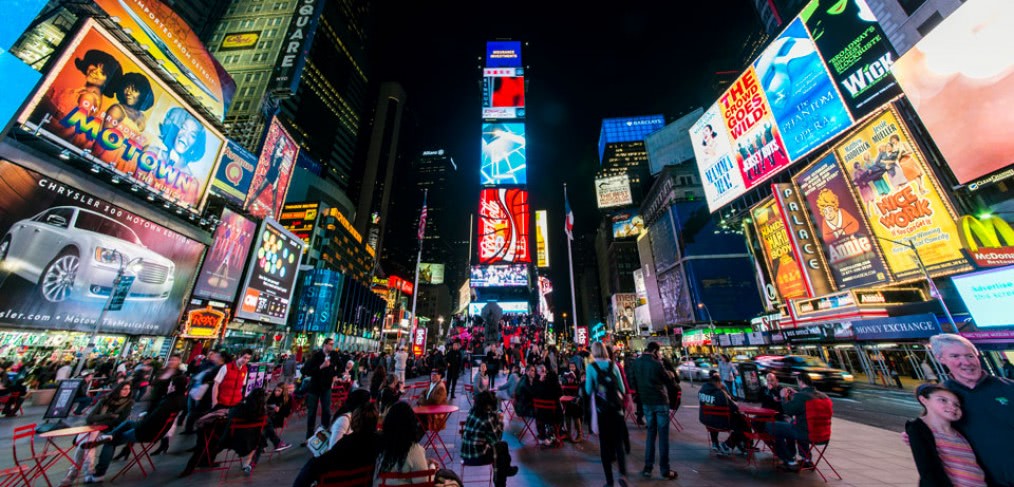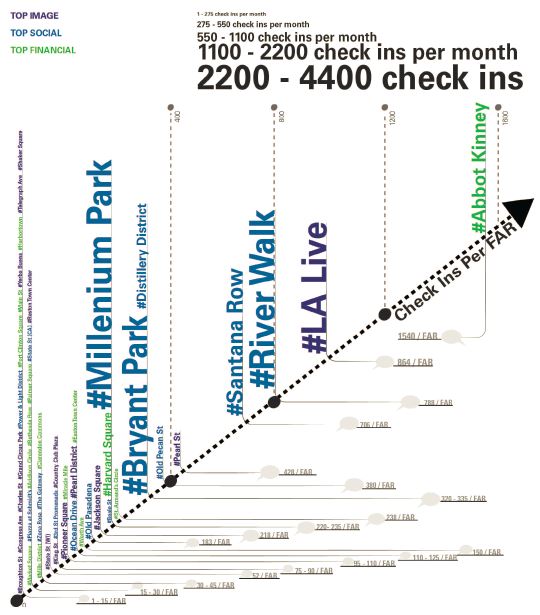
Promoting Social Connection in Cities
As we reflect on our day-to-day experiences, we can all likely bring to mind a number of places where we have lived, worked or visited in which we feel comfortable or inspired. While the factors that foster a meaningful social connection with a place can vary widely, we can optimize and promote improved social connections in urban environments through effective measurement, strategy and design. This approach is grounded in data collected via social media and in-situ observation.
For the last two years, my research and design team has been studying social allegiance in cities, using 50 of the top urban districts throughout North America as our laboratory. Our newly completed study entitled Urban Rx: What Makes Urban Districts Thrive (www.urban-rx.com) identifies several key factors that drive success in public environments. Social allegiance, which we define as the ability for an individual to identify with a particular neighborhood or place, including its people and their collective values, is one of these factors. Why is social allegiance so important to the enduring resilience of cities? Because it leads to long-term investment by individuals, a grouping of which leads to better collective decision-making at the neighborhood level. By extension, strong neighborhoods comprise urban districts, and urban districts define cities. In short, social allegiance is a fundamental building block to long-term resilience in the urban environment.
Our findings from data collection, interviews, and field observation were wide-ranging due to regional differences in culture, climate and urban environments, which inevitably produced some outliers that bucked any trends observed. However, certain key elements were consistently found in those urban districts that created the highest levels of social allegiance.
High performance green spaces:
Of the participants interviewed and tracked via social media, some preferred urban plazas and the accompanying development density, high activity level and sense of freedom and opportunities for self-expression. Others sought a more natural, unstructured environment that serves as a quiet respite from the city. The cities that offered spaces incorporating the best of both worlds scored the highest rate of total social media engagement—for example, Bryant Park in New York City and Millennium Park in Chicago, which offer beautifully landscaped green spaces as well as multi-purpose venues for programming and other entertainment. For both of these parks, social media usage exceeded 2,000 check-ins per month. As extensions of the city grid that also provide natural passive areas featuring local flora and fauna, these places may be justifiably classified as both urban and natural. The efficacy of spaces in generating social allegiance is directly correlated to the successful integration of such a diverse mix of characteristics and uses.
Event programming:
The highest social media usage is associated with places that play host to a high number and large variety of social events. Extreme outliers include LA Live in Los Angeles and Times Square in New York, both of which serve as the venue for over 500 events annually. Event-driven spaces such as these generate a tremendous amount of social media usage, often within the range of 4,000 to 5,000 check-ins per month. The content of social media mentions ranged from frustration with logistical challenges—traffic management, parking and public safety—to enthusiastic and positive posts related to the event programming. Another differentiator that deserves further study is the degree to which these spaces appeal to local residents in comparison to tourists. Regardless, the significance of unique event programming is its ability to create a collective social bond shared by a large quantity of people.
Spaces that do this successfully often earn status as a city’s “cultural hub.” The Third Street Promenade in Santa Monica, CA and the River Walk in San Antonio, TX are prime examples. Social media users mentioning these places were often tracked thousands of miles away in Eastern Europe and Asia, a testament to the power of social allegiance in creating memorable spaces and experiences.
Mixed-use environments focused on community needs:
Some public spaces at the heart of urban districts benefit from market demographics that are well-matched with and supported by a mixed-use environment. Offerings that appeal to the community, including services and amenities, dining, shopping and events, have been established and effectively maintained organically over time. The most notable examples include “high streets” in upscale neighborhoods, such as West Broadway in New York City’s West Village, Charles Street in Boston and Abbot Kinney Boulevard in Venice, CA. Although the rate of social media usage does not rank as high numerically in comparison to other spaces, it is often extremely high when measured against the relative density of development. When measuring the number of check-ins per net density, a space is considered to have high social allegiance at 500 monthly check-ins per 1.0 FAR (floor area ratio). The aforementioned districts often have check-in rates as high as 1,500 per FAR. When a place ranks this highly, it is typically due to a triumvirate of users—residents, tourists and daytime commuters—who contribute to the collective sense of allegiance. Further evidence of positive social allegiance can be found in higher financial returns in these locations compared to county averages.
In summary, it is clear that the best, most socially connected urban districts often exhibit some combination of high performance green spaces, robust event programming and well-established mixed-use environments that serve the community’s needs.
Header Image via Wikipedia

